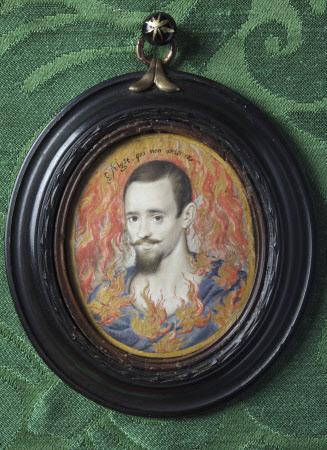A man consumed by flames
Isaac Oliver (Rouen c.1565 – London 1617)
Category
Art / Miniatures
Date
circa 1610
Materials
Watercolour and bodycolour with gold on vellum
Measurements
5.2 x 4.4 cm
Place of origin
England
Order this imageCollection
Ham House, Surrey
NT 1139627
Caption
This dashing and handsome man has chosen to have himself depicted as though consumed by love and passion. He wears classical dress and is shown engulfed in flames, as if to indicate his mental state or fiery ambition. Just above the sitter’s head is a Latin motto, Alget qui non ardet (‘He grows cold who does not burn’), perhaps suggesting that romantic love or religious passion is essential to life. He has been tentatively identified as William Strachey (1572– 1621), an acquaintance of the poet and clergyman John Donne (1572–1631) and a member of the Virginia Company, who was shipwrecked on Bermuda in 1609 and returned to tell the tale. Miniatures were often presented as gifts encased in jewelled lockets and addressed personal and intimate subjects. Isaac Oliver (c.1565–1617) was one of the most celebrated miniaturists and had been a pupil of the renowned Nicholas Hilliard (1547–1619). The picture has been displayed in the ‘Green Closet’ at Ham House in Richmond upon Thames, Surrey, since 1677.
Summary
Watercolour and bodycolour with gold on vellum, A man consumed by flames, by Isaac Oliver (Rouen c.1565 – London 1617), c. 1610. Inscribed in black above the head with the motto 'Alget qui non ardet' (he becomes cold who does not burn). A portrait miniature of a man engulfed in flames, with cropped brown hair and brown spade beard, wearing a gold earring in the proper left ear and a draped blue mantle. The sitter has been tentatively identified as William Strachey (1572– 1621), a member of the Virginia Company (the Company's motto was 'Alget qui non ardet'). The vellum is stuck to card that has been extended by another piece of card, presumably to fit the miniature into its present later seventeenth century turned ebony frame.
Full description
Oliver was appointed as official limner to Anne of Denmark in June 1605, with the same annuity of £40 that the king paid to Nicholas Hilliard. An earlier example by Hilliard of a portrait miniature of a man against a background of flames is in the V&A Museum (P.5-1917). While the idea is not new, Oliver’s treatment of the subject is unusual for showing the sitter engulfed by the blaze. The metaphor of the burning lover was common in Renaissance literature and later emblem books often likened the lover to the mythical salamander, said to have been able to withstand the effects of fire.The portrait may have been among the ‘Therttie eight [pictures] of black Abinie frames’ identified in the Green Closet at Ham House in an inventory of 1677, and could be that identified as ‘My L.d of Essex of Isaac Oliver’ in a later estimate of pictures (c.1683).
Provenance
Probably the Isaac Oliver listed in an Estimate of Pictures of c.1683 at Ham House; thence by descent until acquired in 1948 by HM Government when Sir Lyonel, 4th Bt (1854 – 1952) and Sir Cecil Tollemache, 5th Bt (1886 – 1969) presented Ham House to the National Trust. Ham was entrusted to the care of the Victoria & Albert Museum until 1990, when returned to the care of the National Trust, to whom ownership was transferred in 2002.
Marks and inscriptions
Above head: Alget qui non ardet (he who does not burn grows cold)
Makers and roles
Isaac Oliver (Rouen c.1565 – London 1617), artist
References
Strong 1984 Roy Strong, The English Renaissance Miniature, 1983, revised edition, 1984, p.178 MacLeod 2019: Catharine MacLeod (ed.), Elizabethan Treasures: Miniatures by Hilliard and Oliver, exh.cat., National Portrait Gallery, London 2019, p. 95 Marr 2020 Alexander Marr, 'A mystery in miniature – Isaac Oliver, the Virginia colonists and The Tempest', Apollo, September 2020 Campbell, Falomir, Fletcher and Syson 2011: Lorne Campbell, Miguel Falomir, Jennifer Fletcher and Luke Syson, Renaissance Faces: Van Eyck to Titian (exh. cat.), National Gallery, 15 October 2008 - 18 January 2009 (published 2011) Yakush and Smyth 1985: Mary Yakush and Frances Smyth (eds.), The Treasure Houses of Britain: Five Hundred Years of Private Patronage and Art Collecting, (Washington 1985), p. 117



